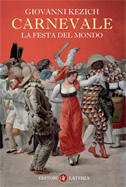RESOURCES - Our publications
Publications of:
- Museo degli Usi e Costumi della Gente Trentina, 2006-2012
- Priuli & Verlucca, editori, 2015
- Royal Anthropological Institute of Great Britain and Ireland, 2017
- Editori Laterza, 2019, 2021
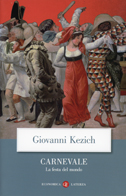 |
• KEZICH Giovanni Carnevale. La festa del mondo, Roma, Editori Laterza, economica Laterza 2021, 232 p., ill. |
|
Prefazione Detestavo il carnevale, p. vii |
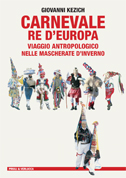 |
awarded: RSI Radiotelevisione svizzera, rete 2 |
Summary: 51 I. CARNEVALE PRIMA DI CARNEVALE 95 II. MASCHERATE DI CAPODANNO E ALTRE PRECOCI 175 IV. APOCALISSI IN MASCHERA 341 V. CARNEVALE DOPO CARNEVALE 471 APPARATI DI CONSULTAZIONE |
|
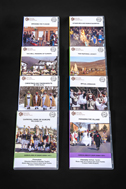 |
• CARNIVAL KING OF EUROPE Collection, Produced by the MUSEO DEGLI USI E COSTUMI DELLA GENTE TRENTINA / TRENTINO FOLKLIFE MUSEUM ROYAL ANTHROPOLOGICAL INSTITUTE ETHNOGRAPHIC FILM CATALOGUE
|
•• DVD 1 CARNIVAL KING OF EUROPE •• •• DVD 2 CHRISTMAS AND THEREABOUTS IN THE ALPS. At the very heart of the winter rituals, Christmas time in the Alps harbours a host of traditional masquerades, from the Day of St. Nicholas to the Epiphany •• • Caroling with the Star among the Bersntoler by Michele Trentini, Museo degli Usi e Costumi della Gente Trentina/Trentino Folklife Museum, 2015, 26' - Italy. In the German-speaking Bersntol (Val dei Mocheni) in the Italian Alps, the Three Wise Men have left in their stead a robust choir of young men, parading the Star from farm to farm. • Sweeping Evil Away in Rauris by Michele Trentini, Museo degli Usi e Costumi della Gente Trentina/Trentino Folklife Museum, 2017, 8' 30'' - Austria. • The Great Epiphany of Wörth by Michele Trentini, Museo degli Usi e Costumi della Gente Trentina/Trentino Folklife Museum, 2017, 13' - Austria. •• DVD 3 THE BELL RINGERS OF EUROPE. The clanging of conspicuous, monumental cowbells is the most distinctive opening sound of a number of European winter masquerades •• • St. Martin’s Bonfires in Predazzo by Michele Trentini, Museo degli Usi e Costumi della Gente Trentina/Trentino Folklife Museum, 2010, 10' - Italy. • The Silvesterchläuse of Hundwil by Michele Trentini, Museo degli Usi e Costumi della Gente Trentina/Trentino Folklife Museum, 2014, 12' - Switzerland. • One day in Rukavac by Michele Trentini, Museo degli Usi e Costumi della Gente Trentina/Trentino Folklife Museum, 2008, 11'. • The Double Walk of the Joaldunak by Michele Trentini, Museo degli Usi e Costumi della Gente Trentina/Trentino Folklife Museum, 2011, 10' - Basque Country, Spain. •• DVD 4. SPEEDING THE PLOUGH. An old plough is the protagonist of the ancient masquerade in a number of European settings, where some explicit reference to ancient agrarian rituals is brought into play •• • A Rite on the Run: the Blùmari of Benecija by Michele Trentini, 2015, Museo degli Usi e Costumi della Gente Trentina/Trentino Folklife Museum, 10' - Italy. • One day in Lancova Vas by Michele Trentini, Museo degli Usi e Costumi della Gente Trentina/Trentino Folklife Museum, 2010, 9' - Slovenia. • One day in Chelnik by Michele Trentini, Museo degli Usi e Costumi della Gente Trentina/Trentino Folklife Museum, 2008, 13' 30'' - Bulgaria. • A good day in Sharnford. God Speed the Plough! by Michele Trentini, Museo degli Usi e Costumi della Gente Trentina/Trentino Folklife Museum, 2010, 14' - England. • Speeding the Plough in Stilfs by Michele Trentini Museo degli Usi e Costumi della Gente Trentina/Trentino Folklife Museum, 2015, 21' 30'' - South Tyrol, Italy. • The Sacred Thresh by Michele Trentini, Museo degli Usi e Costumi della Gente Trentina/Trentino Folklife Museum, 2016, 18' - Austria. •• DVD 5. PARADING THE VILLAGE. On Carnival days, the village is brought back to life thanks to the rejuvenating, well wishing presence of ritual masks •• • The Day of the Pustje on Mt. Matajur by Michele Trentini, Museo degli Usi e Costumi della Gente Trentina/Trentino Folklife Museum, 2015, 11' - Italy. • The Day of the Zanni by Michele Trentini, Museo degli Usi e Costumi della Gente Trentina/Trentino Folklife Museum, 2016, 17' - Italy. • The White Primavera of the Agordino by Michele Trentini, Museo degli Usi e Costumi della Gente Trentina/Trentino Folklife Museum, 2016, 16' - Italy. • The Gnaga by Michele Trentini, Museo degli Usi e Costumi della Gente Trentina/Trentino Folklife Museum, 2017, 7' 30'' - Italy. • A Women’s Carnival in Tyrol by Michele Trentini, Museo degli Usi e Costumi della Gente Trentina/Trentino Folklife Museum, 2017, 9' 20'' - Austria. • Visions of Shrove Thursday in Central Tyrol by Michele Trentini Museo degli Usi e Costumi della Gente Trentina/Trentino Folklife Museum, 2014, 10' - Austria. • Koza Szymborska. The Day of the Goat in Szymborze by Michele Trentini, Museo degli Usi e Costumi della Gente Trentina/Trentino Folklife Museum, 2011, 14' - Poland. •• DVD 6 RITUAL ARMADAS. Often the masquerade is represented by an imaginary, colourful, rumbustious army, with a distinct martial allure of its own •• • Coraggio coscritti: take heart, all new recruits! by Michele Trentini, Museo degli Usi e Costumi della Gente Trentina/Trentino Folklife Museum, 2016, 25' - Italy. • One day in Agnita by Michele Trentini, Museo degli Usi e Costumi della Gente Trentina/Trentino Folklife Museum, 2011, 10' - Romania. • Na vòlta n val de Fiemme (Once upon a time in Val di Fiemme) by Michele Trentini, Museo degli Usi e Costumi della Gente Trentina/Trentino Folklife Museum, 2009, 23' - Italy. • Fiddling away Carnival in Caffaro by Michele Trentini, Museo degli Usi e Costumi della Gente Trentina/Trentino Folklife Museum, 2017, 12' 20'' - Italy. • The Gilles of La Louvière and the Chinels of Fosses-la-Ville by Michele Trentini Museo degli Usi e Costumi della Gente Trentina/Trentino Folklife Museum, 2014, 9' - Belgium. • We can be heroes just for (two) days. The Jannisaries of Naoussa by Michele Trentini, Museo degli Usi e Costumi della Gente Trentina/Trentino Folklife Museum, 2016, 20' - Greece. •• DVD 7. THE PASTORAL LEGACY. The living icons of an idealized pastoral past can often be detected behind the masquerade, revealed by the abundance of fleece in the costumes and the tinkling of bells •• • One day in Begnishte by Michele Trentini, Museo degli Usi e Costumi della Gente Trentina/Trentino Folklife Museum, 2008, 7' - Republic of Macedonia. • The Silvesters of Urnäsch by Michele Trentini, Museo degli Usi e Costumi della Gente Trentina/Trentino Folklife Museum, 2011, 12' 30'' - Switzerland. • The Day of the Masks on the Karst by Michele Trentini, Museo degli Usi e Costumi della Gente Trentina/Trentino Folklife Museum, 2017, 14' - Slovenia. • The Day of the Rams in Gljev by Michele Trentini, Museo degli Usi e Costumi della Gente Trentina/Trentino Folklife Museum, 2012, 17' - Croatia. • St. Anthony Bonfires in Mamoiada by Michele Trentini, Museo degli Usi e Costumi della Gente Trentina/Trentino Folklife Museum, 2014, 17' - Italy. •• DVD 8.STRAW MEN AND HUMAN SACRIFICE. The climax of the masquerade, which marks a turning point in social time, is the staging of a human sacrifice by the burning of a ritual dummy •• • The trial, sentence and execution of Johnny Woodstock by Michele Trentini, Museo degli Usi e Costumi della Gente Trentina/Trentino Folklife Museum, 2010, 14' 30'' - Italy. • The Passion and Death of the Carlisèp by Michele Trentini, Museo degli Usi e Costumi della Gente Trentina/Trentino Folklife Museum, 2015, 19' - Italy. • The Short Happy Life of the Poklad by Michele Trentini, Museo degli Usi e Costumi della Gente Trentina/Trentino Folklife Museum, 2012, 26' 30'' - Croatia. • The Bear Chase by Michele Trentini, Museo degli Usi e Costumi della Gente Trentina/Trentino Folklife Museum, 2009, 7' - France. • The Beautiful White Masks of Rèsije by Michele Trentini, Museo degli Usi e Costumi della Gente Trentina/Trentino Folklife Museum, 2017, 15' - Italy. |
|
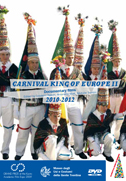 |
• KEZICH Giovanni, MOTT Antonella, TRENTINI Michele (eds.) Carnival King of Europe 2010-2012 Documentary films San Michele all'Adige, Museo degli Usi e Costumi della Gente Trentina, 2012, DVD. |
DVD 1 - Carnival King of Europe, BASQUE COUNTRY (SPAIN ), ENGLAND, POLAND, ITALY • Carnival King of Europe. Release 2.0. A film by Giovanni Kezich & Michele Trentini, Museo degli Usi e Costumi della Gente Trentina, Italy, 2011, 34' DVD 2 - SWITZERLAND, SLOVENIA, CROATIA • The Silvesters of Urnäsch. A film by Michele Trentini, Museo degli Usi e Costumi della Gente Trentina, Italy, 2011, 13' DVD 3 - ROMANIA, BULGARIA, MACEDONIA • One day in Agnita. A film by Michele Trentini, Museo degli Usi e Costumi della Gente Trentina, Italy, 2010, 10' |
|
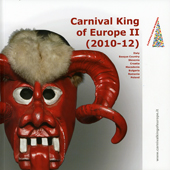 |
• MOTT Antonella (ed.), Carnival King of Europe II (2010-12), San Michele all'Adige (TN), MUCGT, 2012, 155 p., ill. |
| Summary: • Introduction, Giovanni Kezich (Museo degli Usi e Costumi della Gente Trentina, San Michele all'Adige) • Activities 2010-2012, Giovanni Kezich • Exhibition Carnival King of Europe II (2010-2012). Winter fertility masquerades in the European ethnographic context, Giovanni Kezich • Carnival’s many masks: an introduction, Cesare Poppi • The Banderàl, Carano, Fiemme Valley, Trentino, Giovanni Kezich • Carnival and winter. Festivities, fun and religion in the Basque Country, Emilio Xabier Dueñas (Euskal Museoa. Bilbao. Museo Vasco) • The Cerkno Lavfarji. A Slovene Carnival group, Nena Židov, Adela Pukl (Slovenski etnografski muzej, Ljubljana) • Les mascarades et l’identité, Vladimir Bocev (Nacionalna Ustanova Muzej na Makedonija, Skopje) • Kukeri of Vresovo, Iglika Mishkova (The National Ethnographic Museum, Sofia) • The Goat from Cepleniţa village, Iaşi County, Romania, Simona Ghiorghies (Complexul Naţional Muzeal Astra, Sibiu) • Carnival King of Poland, Justyna Laskowska-Otwinowska, Patryk Pawlaczyk, Klara Sielicka-Baryłka, Amudena Rutkowska, Aleksander Robotycki, Grzegorz Rostkowski (Państwowe Muzeum Etnograficzne w Warszawie, Warsaw) |
|
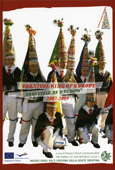 |
• KEZICH Giovanni, MOTT Antonella (a cura di), Carnival King of Europe / Carnevale re d'Europa (2007-2009). Potere, ritualità e i popoli senza storia. Giornate di studio in onore di Eric R. Wolf (1923-1999), nel decennale della scomparsa, San Michele all’Adige (TN), MUCGT, 2011, 478 p., ill. (SM Annali di San Michele; 24). |
Summary: 1. Archeologia e storia, rito e teatro 2. Etnografia - Le Alpi, l'Italia 3. Etnografia - l'Europa 4. Dalle origini al globalismo contemporaneo |
|
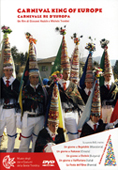 |
• KEZICH Giovanni, TRENTINI Michele, Carnival King of Europe, San Michele all'Adige, Museo degli Usi e Costumi della Gente Trentina, 2009, 22', DVD. Awarded the «Grand Prize for Academic Film», Kyoto University Museum Academic Film EXPO 2009 |
In addition, on this DVD: - One day in Begnishte (Macedonia) by Michele Trentini, MUCGT, 2008, 7' |
|
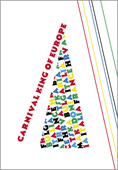 |
vademecum eng. pdf ; vademecum it part I.pdf ; vademecum it part II.pdf |
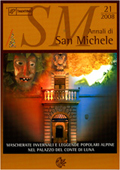 |
• KEZICH Giovanni (et al.), Mascherate invernali e leggende popolari alpine nel palazzo del Conte di Luna, San Michele all’Adige, Museo degli Usi e Costumi della Gente Trentina, 2008, 254 p., ill. (SM Annali di San Michele, 21). |
Summary: Part I – Mascherate invernali 2. Il contesto balcanico |
|
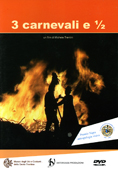 |
• TRENTINI Michele, 3 carnevali e ½, San Michele all'Adige, Museo degli Usi e Costumi della Gente Trentina, 2007, 52', DVD. Awarded the Prize «Costantino Nigra», V edition 2007 Visual Anthropology / Multimedial Systems Section |
Synopsis |
|
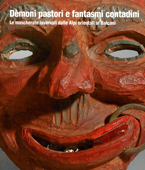 |
• KEZICH Giovanni, POPPI Cesare (a cura di), Dèmoni pastori e fantasmi contadini. Le mascherate invernali dalle Alpi orientali ai Balcani, Civezzano (TN), EsaExpo, 2006, 95 p., ill., Catalogo della mostra tenuta a Trento a Palazzo Roccabruna dal 21 aprile al 14 maggio. |
Summary: Val di Fassa Valfloriana Termeno Jambol. Bulgaria
|
|








